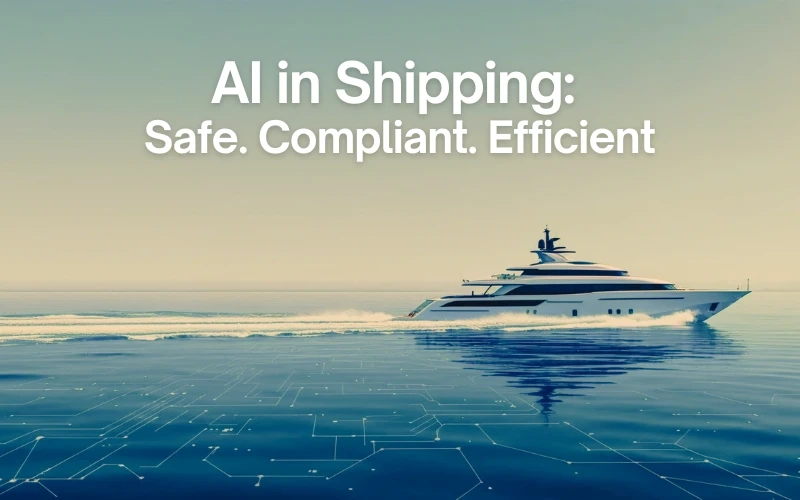Though the sea continues to inspire awe, navigating it is no simple task. For shipowners, captains, and operators, one of the most critical responsibilities is maintaining compliance with safety, environmental, and regulatory standards.
Traditionally, maritime compliance relied heavily on manual tasks—document management, inspections, and routine checks. These processes are time-consuming and vulnerable to error. Now, AI is redefining the landscape by making compliance processes smarter, faster, and more reliable.
Here are four key ways AI is transforming ship compliance and driving the future of maritime operations:
1. Smarter Documents with Natural Language Processing (NLP)
Ships handle a wide array of documents—certificates, reports, manuals, and safety checklists—often in various formats including PDFs, images, and scanned files.
a) Reading and Extracting Data
AI reads and extracts key information such as expiry dates, certificate titles, and equipment details—even from scanned or image-based documents.
b) Automatic Sorting
When a liferaft certificate is uploaded, AI automatically classifies it under safety equipment. Similarly, a calibration report is instantly sorted into the right folder without manual intervention.
c) Quick Summaries
Ai in maritime industry can summarize lengthy documents into brief overviews, making it easier for crews to quickly understand critical points during inspections.
d) Regulation Comparison
NLP tools can evaluate a document against global maritime regulations, highlighting any discrepancies instantly—saving hours of manual checking.
2. Visual Checks Using Computer Vision
AI goes beyond text—it can also interpret visuals. Through computer vision, AI can analyze images and videos for inspection and safety compliance.
Example 1: Liferaft Inspection
A photograph of the liferaft is analyzed by AI to check its condition and verify details like the ship’s name and port of registry.
Example 2: Guardrail Check
During new vessel inspections, AI assesses guardrail height and security by analyzing reference points in the image.
Example 3: Drill Review
AI reviews videos of drills, such as a Man Overboard (MOB) exercise, to confirm whether procedures followed safety protocols correctly.
AI acts as a digital inspector—fast, accurate, and consistent in evaluating visual data.
3. Predictive Insights through Machine Learning
Machine learning uses historical and real-time data to forecast issues and enhance operational readiness.
a) Failure Predictions
AI analyzes data from onboard sensors—engine temperature, fuel usage, vibrations—to predict potential failures before they happen.
b) Inspection Risk Forecasting
Based on previous inspection data, ship age, cargo, maintenance history, and crew experience, AI identifies areas likely to be flagged in upcoming inspections.
c) Inspection Report Analysis
Using NLP, AI reviews old inspection reports to detect recurring concerns and proactively reminds crews about potential focus areas.
These predictive tools are now core features of advanced AI maritime compliance software.
4. Automated Compliance Workflows
Beyond analysis, AI also enables automatic execution of follow-up actions based on data insights.
Example 1: Non-Compliance Alerts
If a document is found to be outdated or non-compliant, AI immediately sends a notification to the captain or relevant officer.
Example 2: Expiry Reminders
AI tracks document validity and sends reminders well in advance—allowing the crew to act before deadlines are missed.
This automation reduces the need for manual monitoring and significantly lowers the chances of errors or oversights.
Why AI Matters in the Maritime World
The sea may remain unchanged, but the shipping industry faces rising pressure to keep up with complex and growing regulatory demands. AI provides the tools needed to meet these challenges.
It saves time and reduces manual workload, minimizes human error, predicts issues before they occur, accelerates inspections and approvals, and helps ensure global compliance.
The future of shipping is smart. With AI technologies like NLP, computer vision, and machine learning, compliance procedures that once took days can now be completed in minutes. More importantly, ships can move from reactive approaches to proactive operations.
As ship compliance software adoption grows, maritime operations will become more efficient, safer, and fully compliant. If your fleet has not yet integrated AI, now is the right time to embrace intelligent maritime software and transform your compliance strategy.


